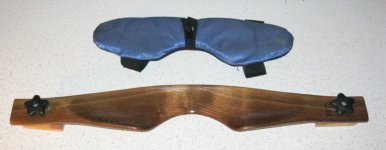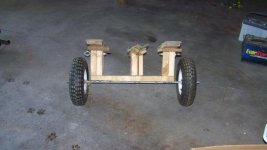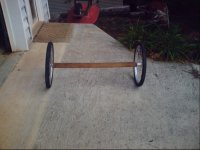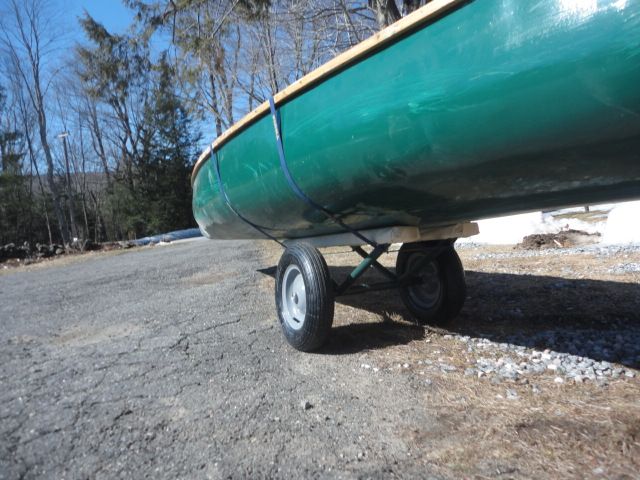I recently purchased an Old Town Yankee and it doesn't have a center thwart. I'd like to keep the boat original and a removeable yolk sounds like a pain just to move the boat 50 feet or so. How do you guys move these boats short distances by yourself.
-
Happy National Nurses Day! 🛌👩⚕💉💊🎉
You are using an out of date browser. It may not display this or other websites correctly.
You should upgrade or use an alternative browser.
You should upgrade or use an alternative browser.
How do I carry my new boat?
- Thread starter lowangle al
- Start date
Seekers got the same boat. I have another w/c canoe that lacks a center thwart. I use a Swedish type center mount canoe cart. But that might be overkill(over spend) for fifty feet.
G
Guest
Guest
Thwart on the shoulder with a pool noddle for padding?
Turtle
Turtle
Lots of padding.. its 36 inches wide and 67 lbs. Oh my aching back at the thought of that!Thwart on the shoulder with a pool noddle for padding?
Turtle
safer might be a moving dolly used to roll furniture around if level ground is involved.
Thanks for the replys. So like I thought, either install a thwart, use a cart or man handle it. What are the views in the traditional boat community on installing a thwart in a boat that didn't have one origionally? Anyone know why some of these boats didn't have center thwarts? The only reason I can think of would be to have a large unobstructed cargo area, I couldn't imagine it was to cut production cost.
A well designed removable portage yoke shouldn't be a pain to put on. The one for my solo canoe takes less than 10 seconds to place and secure. A removable yoke has the added advantage of leaving your canoe in original condition.
Personally, I would never add something to a w/c canoe that wasn't originally there. The exception was my 14 foot Chestnut which was a newer model so an extra set of holes in the inwales to hang a single seat did not involve too much crying. No center thwart in that boat so I made this... 
I bought a Teal yoke then modified it for easy on/off.

I bought a Teal yoke then modified it for easy on/off.
Thanks Praire Pete, that may be my best option, 10 seconds sounds pretty good.
G
Guest
Guest
Whoops,I meant gunnel on shoulder.
Turtle
Turtle
Historically many canoes never had center thwarts and yokes were unheard of.. You made your own by lashing two paddles one on each side. One grip on bow thwart and the blade on stern thwart. Some folks still swear by this. But its a lot of bother for carrying 50 feet. Some also made leather or other fabric that lay across the shoulders and each end secured in the gunwale. This works fine for open gunwaled boats. You might try belting some belts together that fit in the slots in the gunwales.
If you use a detachable yoke make sure the clamps are well padded if metal and wood is way nicer.
Courting canoes never had center thwarts nor some cargo haulers as you already indicated.
If you use a detachable yoke make sure the clamps are well padded if metal and wood is way nicer.
Courting canoes never had center thwarts nor some cargo haulers as you already indicated.
Thanks again. That is a nice looking yolk Mihun and it looks pretty simple. Turtle I thought that was probably what you meant, but that's what I was trying to avoid.
I think I need to embrace the fact that it has no center thwart and look at benefits. More room for stand up paddling and flyfishing and maybe some poleing, if I ever have to sleep under it the thwart won't be in the way and most importantly lots of room for courting.
I think I need to embrace the fact that it has no center thwart and look at benefits. More room for stand up paddling and flyfishing and maybe some poleing, if I ever have to sleep under it the thwart won't be in the way and most importantly lots of room for courting.
Although I have never gotten to it I always wanted to make a removable yoke for my OT wc Guide similar to those used on Adirondack guideboats. Easily removed/installed and does not inhibit open space for gear stowage. Similar to one pictured here http://www.guideboats.com/construction/
My Chestnuts all have center thwarts, and the second thwart on my 16' Chestnut Pal is moved towards the center rather than behind the bow seat making it easy to solo from the bow seat canoe turned around. The other thwart on a the Pal is dead center. Chums, Bob's, Prospector's all have center thwart's, nice feature imo.
I agree that a center thwart is a good feature Robin but are you saying I should have gotten a different boat or that I should install one and move or remove the foward thwart because I will be paddleing solo from the bow seat. This would be the most practical set up for me.
....are you saying I should have gotten a different boat or that I should install one and move or remove the foward thwart because I will be paddleing solo from the bow seat. This would be the most practical set up for me.
No That's a great boat you have, a real keeper imo. I just saw a chance to mention Chestnuts and I took it...haha
I see two problems, no center thwart and that bow thwart being in the way for solo paddling from the bow seat canoe turned around.
Now if it was my canoe, and I planned on paddling it solo for the most part, I would try making a temp center thwart, and see how the canoe paddles with the bow thwart removed and the temp thwart installed. It might be just too shaky and too much weight on the rails up near the bow seat without the support gained from the front thwart.
But how can you sit in the bow seat reversed with that thwart in the way? Add a cushion and have that thwart always under your knees? Knell?
Drilling holes in the inwales is not a great option, but it's been done. I have no good answer for someone else's canoe, but I would try the temp center thwart especially if you have to get the canoe on the roof of a vehicle by yourself, or off the vehicle and carry it 50'
Thanks Robin, this will be my first w/c canoe, I got it for my retirement home that is on a lake in NE Pa.. I plan on paddleing almost daily and expect that I will carry the boat up to the garage every night. Would this be recomended or would it be OK to keep it outside by the water resting on the gunnels off the ground for the season. I want to use the boat but not abuse it. Would it be a waste of energy bringing it in every night?
I just picked up an wood canvas Old Town OCTA that has been outside the last 3 summers. It was up side down, up on horses. The rain would run down the hull to the gunnels which had a decent coat of paint on their undersides, then run down the gunnels to the bow and stern. The water curled around the gunnels and somehow rotted the end of one stem. One gunnel also shows sign of being a little bit punky, especially around the end.
I would avoid leaving the canoe outside if at all possible, sounds like a small canoe cart would be a good option, then you could even avoid lifting the canoe over your shoulders.
I would avoid leaving the canoe outside if at all possible, sounds like a small canoe cart would be a good option, then you could even avoid lifting the canoe over your shoulders.
Yup, from the cabin to the water a cart would definitely be the easiest, cheapest, and smartest way to go imo too. It's not very difficult to diy a simple canoe cart. Many many pics are available just Google search diy canoe cart. Yours would not have to be too involved as you can just leave it on shore while you are on the water.
Similar threads
- Replies
- 15
- Views
- 1K
- Replies
- 29
- Views
- 2K
- Replies
- 8
- Views
- 1K




